
Van Life Guide to Managing Meals on the Road
Van Life Guide to Managing Meals on the Road
In-depth tips for food storage and cooking in your rolling home.
By: Kelly Laustsen & David Somach
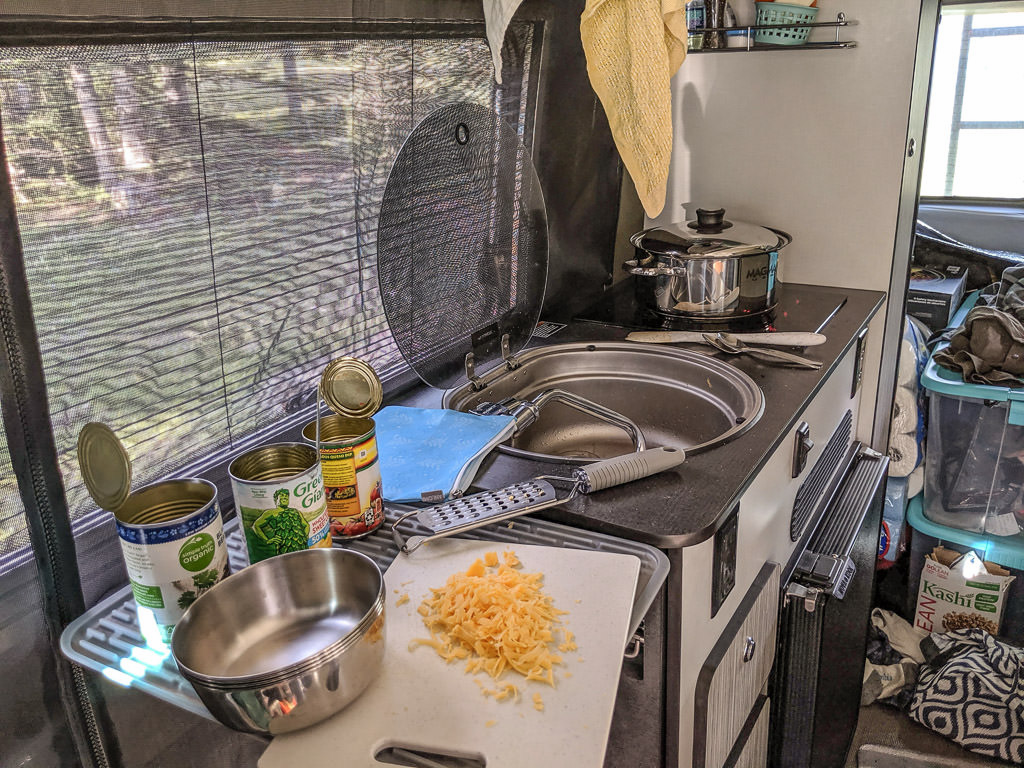
We’ve found that, while traveling, it is helpful to develop a routine to offset the unpredictability of life on the road. A routine helps the van feel like home and provides some needed consistency. Some of our biggest routines revolve around mealtimes. We mostly dine in the van, with some meals to explore the local food scene when in cities.
We try to make meals that are simple, healthy, and tasty. Redundancy and leftovers don’t bother us. For us, it works to plan a few meals ahead and think about when we’ll next go to the grocery store. While we don’t want to run out of food, we also don’t want to have more food than we can easily store. We usually like to buy in bulk or stock up when there is a good sale. But after once buying three large bags of tortilla chips and four boxes of cereal, we learned that stockpiling isn’t practical in the van.
While we’ve tweaked our shopping habits, we eat similarly to how we ate when living in a house, which is one of the reasons we feel so comfortable in our Revel and it truly feels like home. You don’t have to sacrifice on food or “rough it” just because you are in a van!
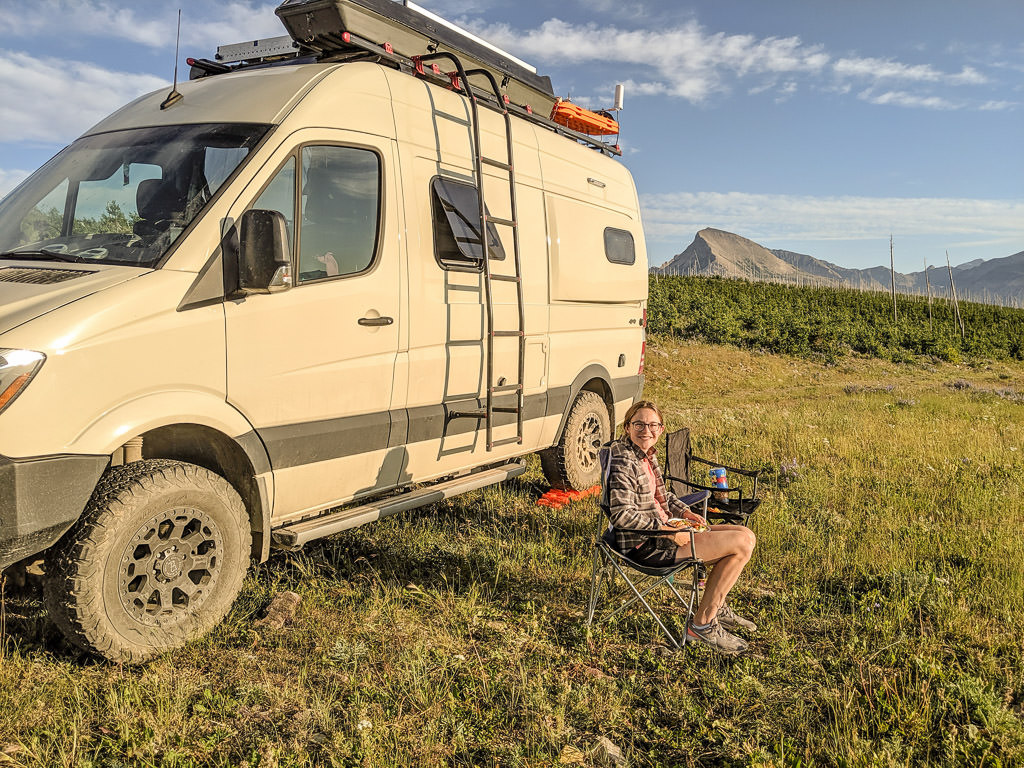
Food Storage: Where Do We Keep Food?
We get stopped in parking lots, scenic overlooks and trailheads all the time by curious onlookers yearning for a peek inside our van. Sometimes it starts out with, “does this thing have 4x4?” or “I’ve been thinking about getting a van like this!” or guesses at what our license plate (GNRWGN) stands for. When we open up the side door to show off the inside of our home, people are always surprised by just how much is inside. The fridge, induction stove, and cabinets are always a hit (and no one guesses a toilet and shower could possibly fit inside the van).
After a few iterations, we have gotten our food storage down to a science, so unloading after a grocery store trip is easy. We’ve decided to put our food in the most accessible places in the van and save some of the harder to reach storage for our backpacking gear, toolkit, portable fire pit, and telescope. This means our cabinet space is almost entirely devoted to food and meal preparation.
Our key storage locations include:
- The fridge. At first, we were a little concerned about fitting everything in our 2.5-cubic-foot fridge. But with a little creativity, we are able to stock enough food for at least a week. We use three glass jars to store a gallon of milk (more cost effective and environmentally friendly than two half gallons, which would fit in the fridge). We also try to buy dense food that will last a while, like eggs, large blocks of cheese, lunch meat, carrots, and peas.
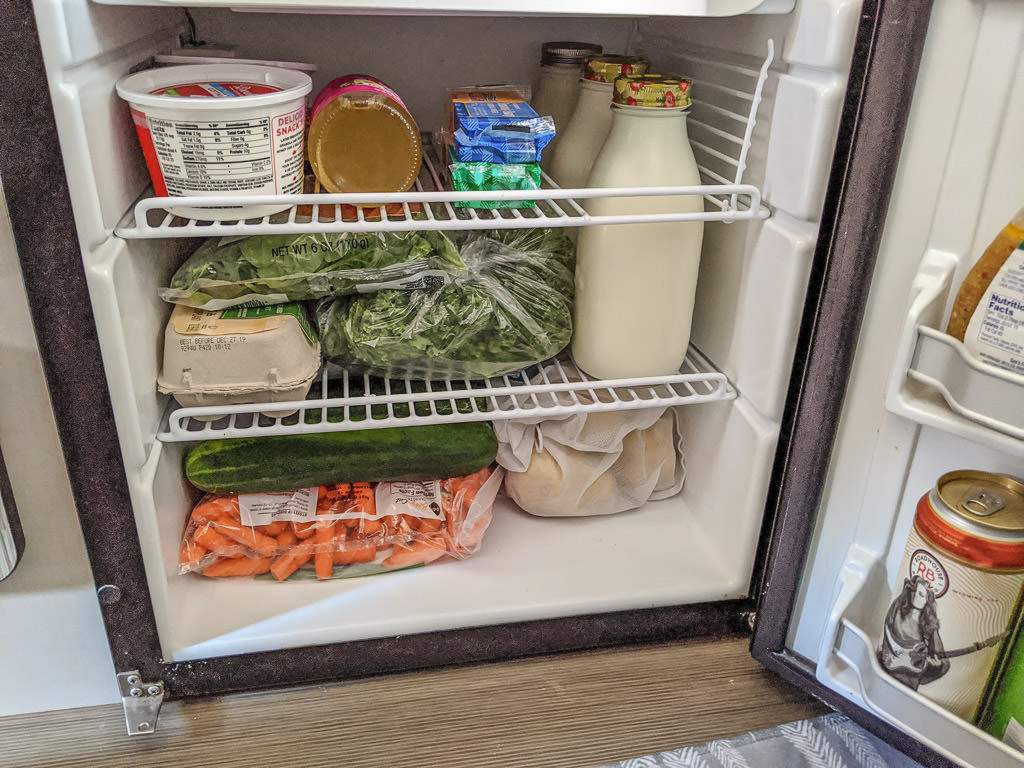
- Cabinet above the sink. We use plastic containers to maximize the space in this cabinet and avoid having to stack boxes of food. We’ll transfer cereal, rice and crackers to the containers right after grocery shopping and then break down the boxes for recycling and save the plastic bags as trash bags.
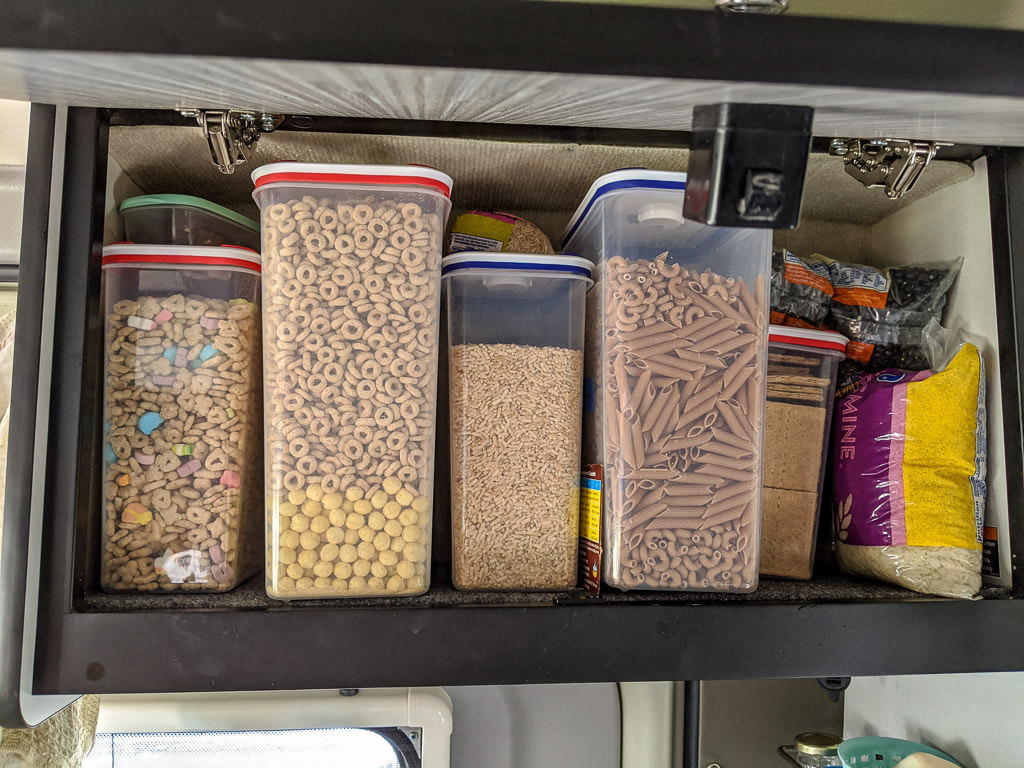
- Pantry. We added three more shelves to the pantry so we can really pack in a lot of goods. We’ve developed a system of what we keep on each shelf, so we know how to find it! The lesser-used items are in the back (soy sauce, popcorn kernels, whiskey) and the daily items are in front.
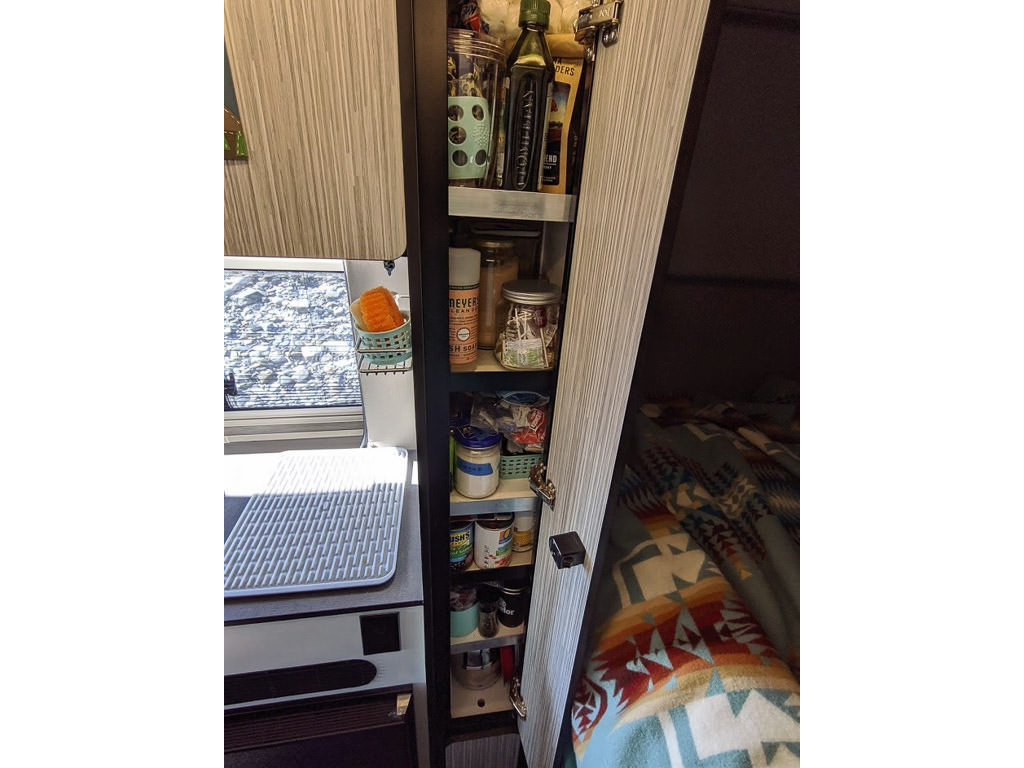
- Cabinet above the bench seat. We keep a shoe box with spices in this cabinet along with our coffee making supplies, bread, and snacks. We tried to pare down to just a few spices, but we are traveling for long enough that we enjoy variety.
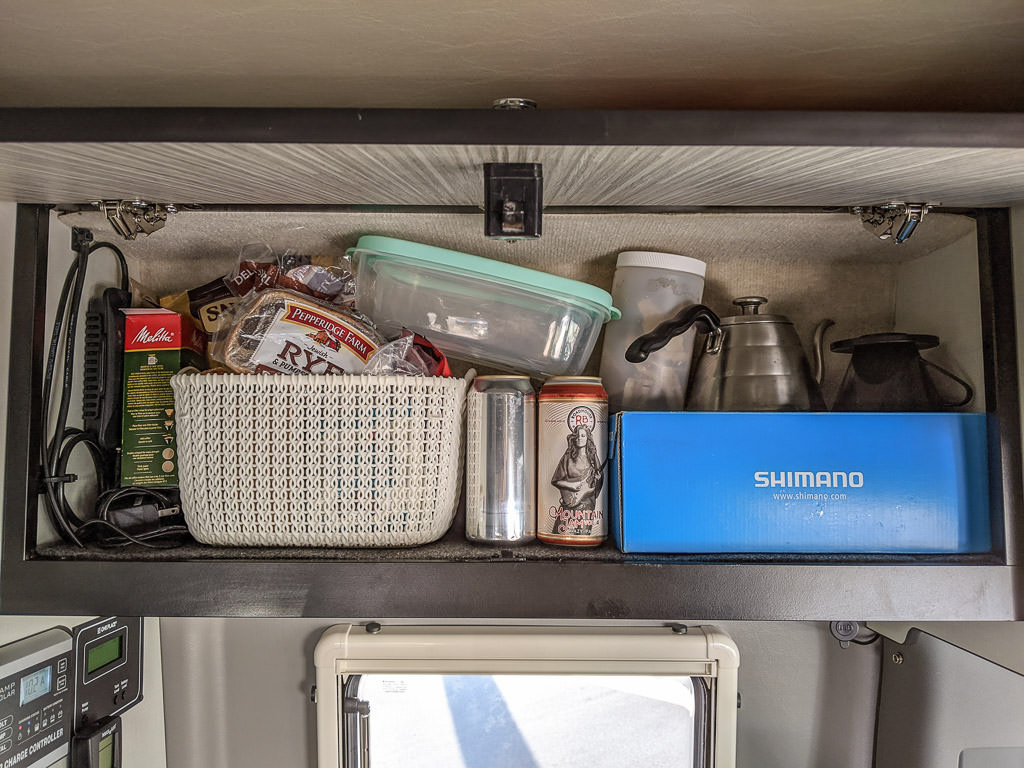
- Fruit basket above the front seats. We love fruit and tend to buy big bags of apples or oranges, especially when we will be out in the woods for a few days. We’ve tried lots of ways of storing fruit, but have settled on a basket that fits nicely in the shelf above the front seats. We added this shelf after meeting other Revelers who said it was the best addition they made to their van.
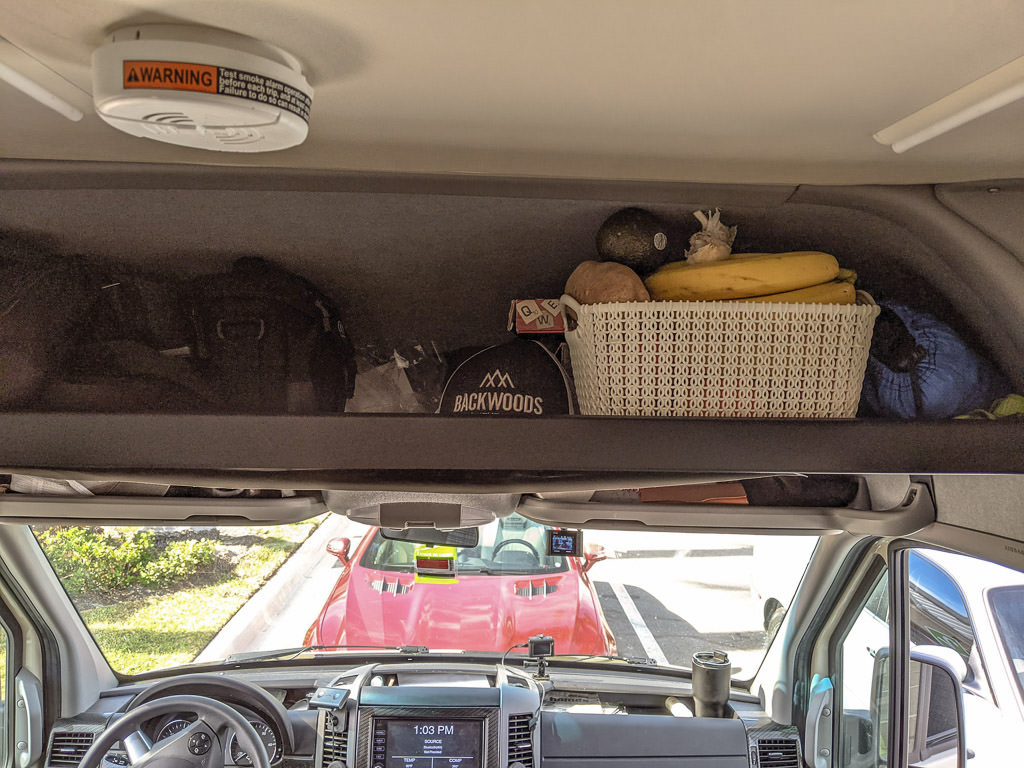
- Several large water bottles. We keep a big water bottle supply for drinking that we fill up at every opportunity (a park, rest stop, grocery store). This helps make our water storage last longer so we can save the water in our tank for dishes and showering.
Buying Food: Where Do We Shop & What Do We Buy?
We do most of our grocery shopping at grocery stores, but do supplement with local food markets, farm stands, and Harvest Hosts stops (a program where wineries, farms, breweries, and other local destinations host RVers for a night).
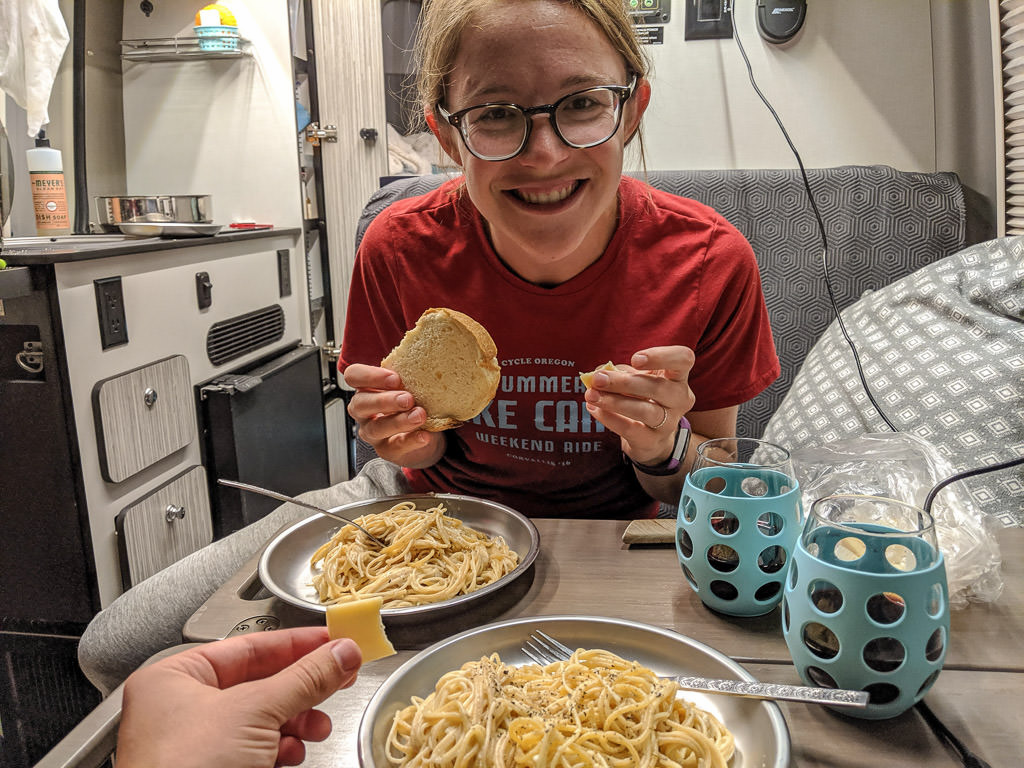
Here are some of our tips to keep in mind when shopping:
- Know the limits of your refrigerator. It takes some practice to learn how much you can fit in your refrigerator, so that you don’t overbuy but still take advantage of all the room you have. We’ve created some Tetris puzzles for ourselves when we’ve overbought before, but we’ve always managed to make it fit!
- Don’t overbuy—there will be another grocery store. It makes for a much more comfortable van when you don’t buy more than you can fit in your storage space.
- Focus on the essentials, along with a couple special treats. We keep staples on hand with a few back-up meals in case we don’t find a grocery store as soon as we expect to. Our staples include canned beans, tomatoes and vegetables as well as rice, eggs, cheese, tuna packets, soup, energy bars, fruit, and carrots. We always have a few special treats like chocolate to snack on while driving or camping that make us feel more at home.
- Plan a couple meals before you get to the store. We generally pick two dinner meals and identify which ingredients we need before we get to the grocery store. We’ll make four servings each time we cook to have leftovers.
Gadgets & Cookware: What Supplies are the Most Necessary?
We try to have minimal kitchen gadgets. These include a nested induction stove cook set with a small pot, large pot, and skillet that we keep under the bed. We have metal plates, bowls and cups that won’t break when dropped. One of the drawers next to the sink holds all of our utensils, including a few spatulas, large spoons, cheese grater, and can opener. We like the advice to bring less than you think you’ll need as you can always pick up things on the road.
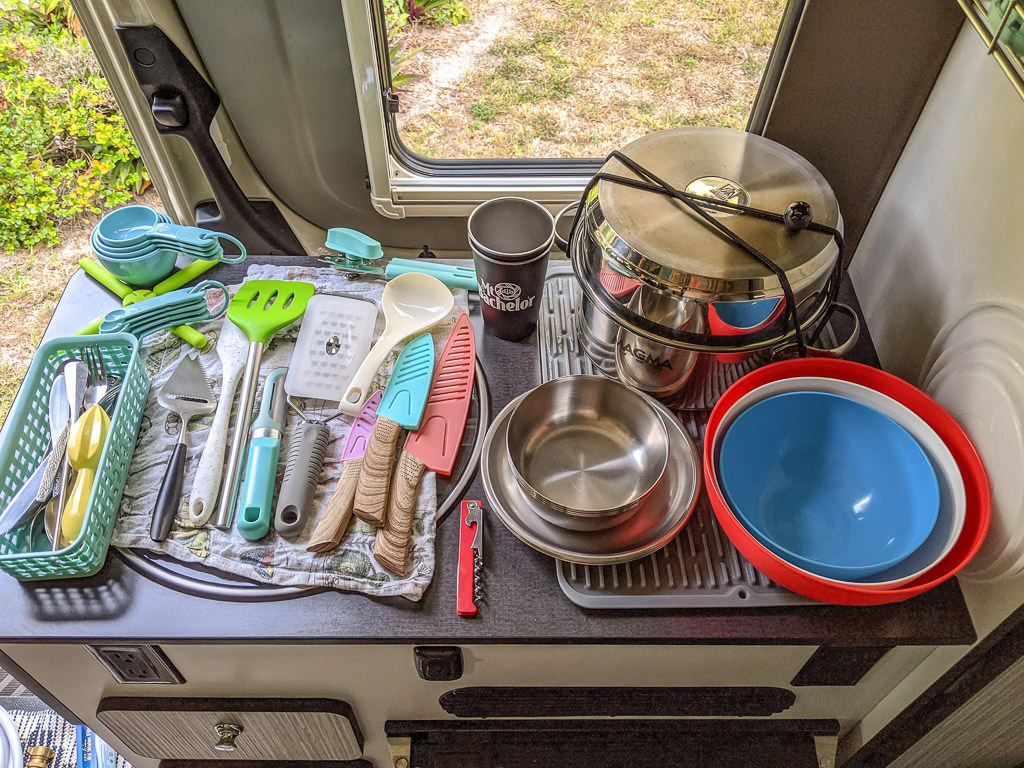
We do have a few bonus items that definitely aren’t essential, but provide us a lot of joy. If something is important to your daily routine, then try and find a way to bring it. For us, these include:
- NutriBullet for smoothies, margaritas, and blended soups. We like making post-work-out smoothies with banana, spinach, chocolate protein powder, and almond milk. When we are craving more fruit and vegetables, we’ll mix a banana, spinach, a couple oranges, and water for a snack.
- Instant Pot for soups and stews. We were convinced to try out the Instant Pot by our families and saw it recommended on a few van forums. While we were skeptical of how much we’d use it, it has been a great addition to the van to provide variety and quickly make soups or beans from scratch. (More Instant Pot recipe ideas here).
- Coffee set-up for pour over, including a kettle with a temperature sensor. We love trying new coffee and will buy a bag of beans in a coffee shop or grocery store when we run out.
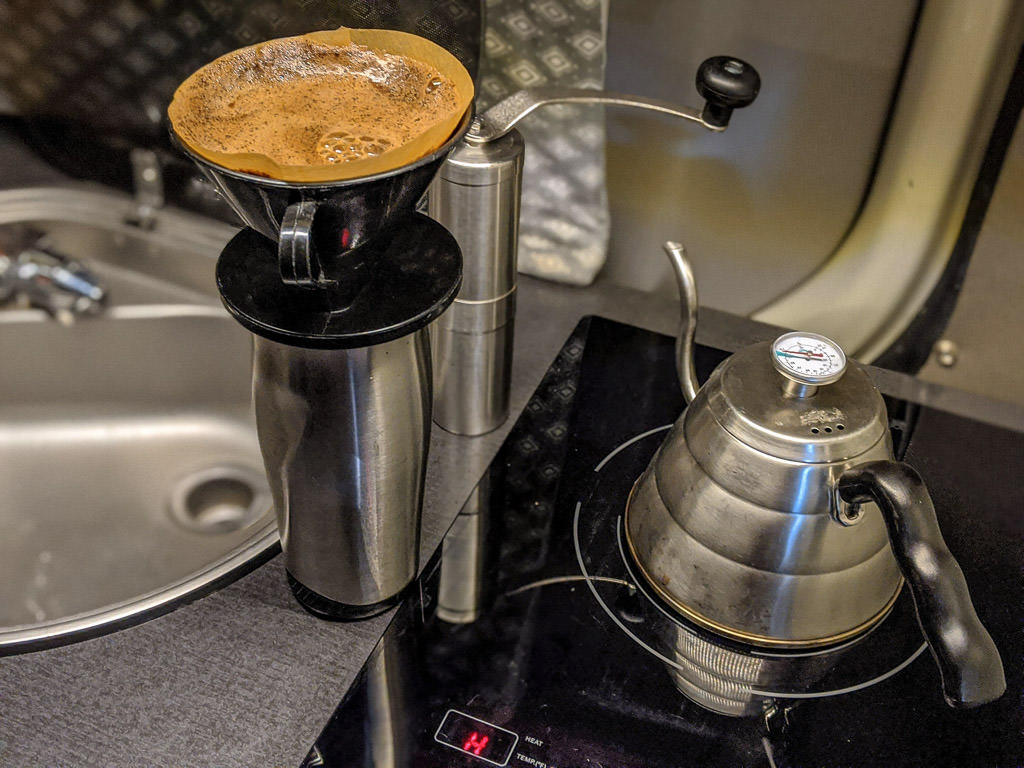
Meal Ideas: What Do We Typically Eat in the Revel?
A hot meal is satisfying when on the road, so we use the induction stove for most meals. It is just so quick and easy. We’ve worked out a routine in the van kitchen, so we don’t step on each other’s toes. One of us will use the stove while the other prepares food on the foldout table or counter. It takes a little more communication to move around compared to our kitchen at home, but we’ve found the van to be plenty spacious.
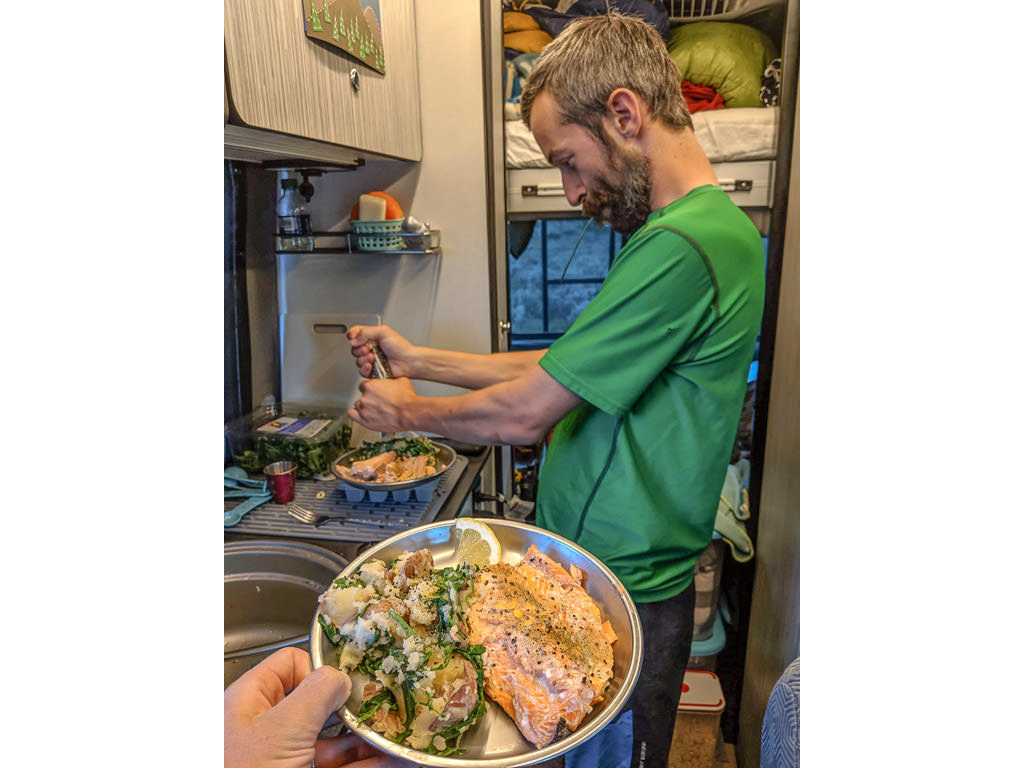
We seek out meals that don’t require a lot of ingredients and work with what we typically keep on hand, but are still flavorful and interesting. We’ll mix up our meals, but eat mostly the same thing between grocery trips (i.e. if we buy bagels, we’ll eat them a few days in a row to use them up before they go bad).
Our typical menu includes the following:
Breakfast
- Cereal with banana and milk
- Bagel and cream cheese
- Eggs and toast/English muffin/bagel
- Scrambled eggs with cheese, ham, onions, or peppers
Lunch
- Grilled cheese and lunch meat or canned tuna with mustard or olive tapenade
- Large salad with spinach or arugula, apple, peas, carrots, shredded cheese, peanuts or sunflower seeds, and dressing
- Yogurt, fruit, and cereal
- Scrambled egg sandwich
- Nachos with cheese, beans, and salsa on the stove
- Rice, beans, and cheese
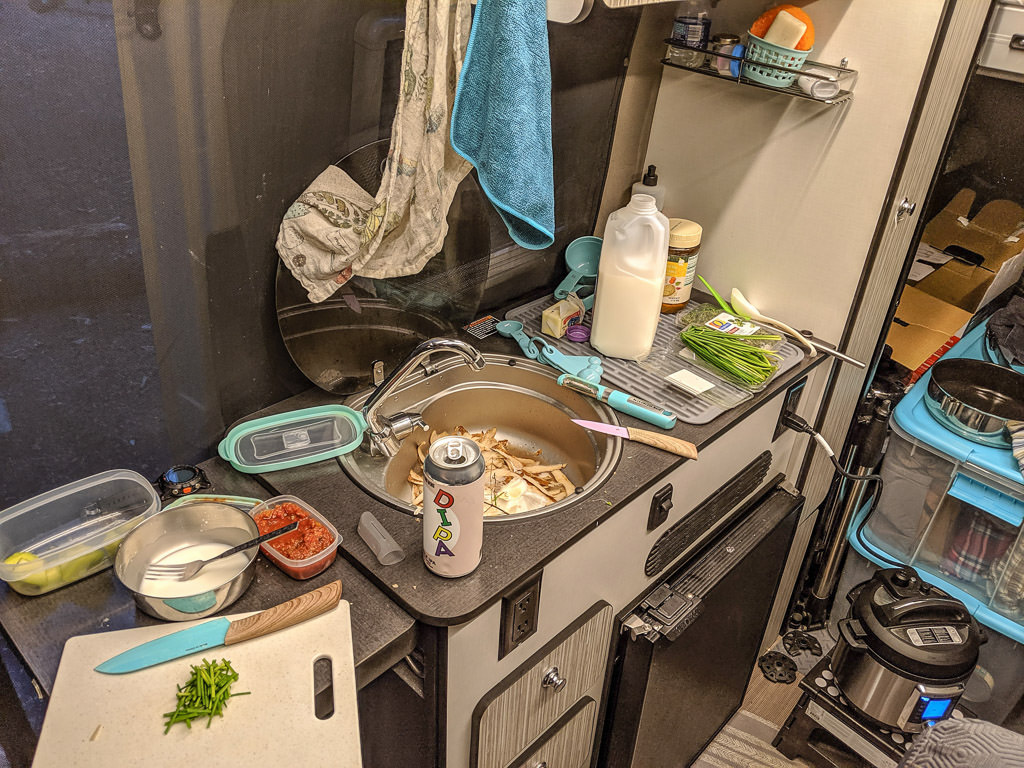
Dinner
- One pot stir-fry with veggies (carrots, broccoli, peas, peppers) and tofu. We’ll eat the stir fry over rice we make up first and use a bottled sauce or a simple peanut sauce.
- Carbonara pasta or spaghetti with fried eggs and parmesan cheese
- Soup in the Instant Pot—we do a lot of varieties with either black beans or lentils as the base. If we are using black beans, we’ll add onions, canned tomatoes, corn, carrots, and taco seasoning. If using lentils, we’ll add whatever veggies we have on hand, brown rice, and Italian seasoning. We like to add shredded cheese and cilantro as toppings. Cilantro is one of our favorite fresh herbs to buy as we can use it in several different meals given its versatility. If we make the soup on the stove instead of in the Instant Pot, we’ll sub in canned beans and sauté the vegetables first.
Snacks
- Roasted almonds
- Fruit
- Popcorn made on the induction stove in a large pot with olive oil and salt
- Pretzels and peanut butter
- Cheese and crackers
We are always looking for new recipes and easy meals to try. We’ll browse cookbooks at libraries or search our favorite food blogs for new ideas. Cooking in the van is an adventure, especially when we are parked out in the woods.
What are your favorite meals or best tips for cooking and storing food in a small space?
Comments
Comments on this post are moderated, so they will not appear instantly. All relevant questions and helpful notes are welcome! If you have a service inquiry or question related to your RV, please reach out to the customer care team directly using the phone numbers or contact form on this page .